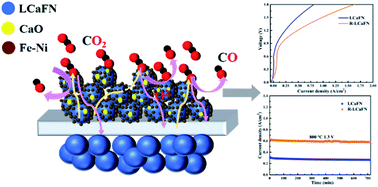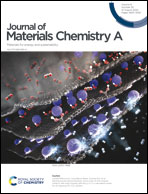Boosting CO2 electrolysis performance via calcium-oxide-looping combined with in situ exsolved Ni–Fe nanoparticles in a symmetrical solid oxide electrolysis cell†
Abstract
The electrocatalysis of CO2 to valuable chemical products is an important strategy to combat global warming. Symmetrical solid oxide electrolysis cells have been extensively recognized for their CO2 electrolysis abilities due to their high efficiency, low cost, and reliability. Here, we produced a novel electrode containing calcium oxide-looping and in situ exsolved Ni–Fe nanoparticles by performing a one-step reduction of La0.6Ca0.4Fe0.8Ni0.2O3−δ (LCaFN). The CO2 captured by CaO was electrolyzed in situ by the Ni–Fe nanocatalysts. The cell with this special cathode showed a higher current density (0.632 A cm−2vs. 0.32 A cm−2) and lower polarization resistance (0.399 Ω cm2vs. 0.662 Ω cm2) than the unreduced LCaFN cathode at 800 °C with an applied voltage of 1.3 V. Use of the developed novel electrode offers a promising strategy for CO2 electrolysis.

- This article is part of the themed collection: Journal of Materials Chemistry A HOT Papers


 Please wait while we load your content...
Please wait while we load your content...